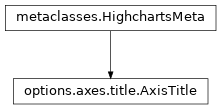.title
class: AxisTitle
- class AxisTitle(**kwargs)[source]
The axis title, shown next to the axis line.
Class Inheritance

- copy(other=None, overwrite=True, **kwargs)
Copy the configuration settings from this instance to the
otherinstance.- Parameters:
other (
HighchartsMeta) – The target instance to which the properties of this instance should be copied. IfNone, will create a new instance and populate it with properties copied fromself. Defaults toNone.overwrite (
bool) – ifTrue, properties inotherthat are already set will be overwritten by their counterparts inself. Defaults toTrue.kwargs – Additional keyword arguments. Some special descendents of
HighchartsMetamay have special implementations of this method which rely on additional keyword arguments.
- Returns:
A mutated version of
otherwith new property values
- classmethod from_dict(as_dict: dict, allow_snake_case: bool = True)
Construct an instance of the class from a
dictobject.
- classmethod from_js_literal(as_str_or_file, allow_snake_case: bool = True, _break_loop_on_failure: bool = False)
Return a Python object representation of a Highcharts JavaScript object literal.
- Parameters:
as_str_or_file (
str) – The JavaScript object literal, represented either as astror as a filename which contains the JS object literal.allow_snake_case (
bool) – IfTrue, interpretssnake_casekeys as equivalent tocamelCasekeys. Defaults toTrue._break_loop_on_failure (
bool) – IfTrue, will break any looping operations in the event of a failure. Otherwise, will attempt to repair the failure. Defaults toFalse.
- Returns:
A Python object representation of the Highcharts JavaScript object literal.
- Return type:
HighchartsMeta
- classmethod from_json(as_json_or_file, allow_snake_case: bool = True)
Construct an instance of the class from a JSON string.
- Parameters:
as_json_or_file – The JSON string for the object or the filename of a file that contains the JSON string.
allow_snake_case (
bool) – IfTrue, interpretssnake_casekeys as equivalent tocamelCasekeys. Defaults toTrue.
- Returns:
A Python objcet representation of
as_json.- Return type:
HighchartsMeta
- to_dict() dict
Generate a
dictrepresentation of the object compatible with the Highcharts JavaScript library.Note
The
dictrepresentation has a property structure and naming convention that is intentionally consistent with the Highcharts JavaScript library. This is not Pythonic, but it makes managing the interplay between the two languages much, much simpler.
- to_js_literal(filename=None, encoding='utf-8') str | None
Return the object represented as a
strcontaining the JavaScript object literal.
- to_json(filename=None, encoding='utf-8')
Generate a JSON string/byte string representation of the object compatible with the Highcharts JavaScript library.
Note
This method will either return a standard
stror abytesobject depending on the JSON serialization library you are using. For example, if your environment has orjson, the result will be abytesrepresentation of the string.- Parameters:
- Returns:
A JSON representation of the object compatible with the Highcharts library.
- Return type:
- static trim_dict(untrimmed: dict, to_json: bool = False) dict
Remove keys from
untrimmedwhose values areNoneand convert values that have.to_dict()methods.
- static trim_iterable(untrimmed, to_json=False)
Convert any
EnforcedNullTypevalues inuntrimmedto'null'.
- property align: str | None
Alignment of the title relative to the axis values. Defaults to
middle.Accepts:
'low''middle''high'
- Return type:
- property margin: int | float | Decimal | None
The distance (in pixels) between the axis labels or line and the title. Defaults to
None, which applies0for horizontal axes and10for vertical axes.- Return type:
numeric or
None
- property offset: int | float | Decimal | None
The explicitly-provided distance of the axis title from the axis line. Defaults to
None.When
None, this distance is computed from the offset width of the labels, the labels’ distance from the axis, and the title’smargin. However when theoffsetoption is set, all this gets overridden.- Return type:
numeric or
None
- property position_3d: str | None
Defines how the title is to be repositioned according to the 3D chart orientation. Defaults to
Nonewhich applies the setting fromAxisLabeLOptions.position_3d().Accepts the following values:
'offset'(the default) - maintains a fixed horizontal/vertical distance from the tick marks, despite the chart orientation. This is backwards-compatible behavior, and causes skewing of X and Z axes.'chart'- preserve the 3D position relative to the chart. This looks nice, but it is hard to read if the text isn’t forward-facing.'flap'- rotated text along the axis to compensate for the chart orientation. This tries to maintain text as legible as possible on all orientations.'ortho'- rotates text along the axis direction so that the labels are orthogonal to the axis. This is very similar to'flap', but prevents skewing the labels (X and Y scaling are still present).
- property rotation: int | float | Decimal | None
Rotation of the title in degrees, where
0is horizontal and270is vertical reading from bottom to top. Defaults to0.- Return type:
numeric or
None
- property skew_3d: bool | None
If
True, the title will skewed to follow the perspective. Defaults toNone, which applies the same setting as set forAxisLabeLOptions.skew_3d().Note
Setting this to
Truewill fix overlapping labels and titles, but texts become less legible due to the distortion. The final appearance depends heavily onposition_3d.
- property style: str | None
CSS styling to apply to the title. Defaults to
None.Hint
If the title length is longer than the axis length, the title will wrap by default. The following three methods can all prevent the title from wrapping in such a situation:
Setting
"textOverflow: 'ellipsis'"in thestyleSetting
"whiteSpace: 'nowrap'"in thestyleSetting an explicit
AxisTitle.width()
- property text: EnforcedNullType | str | None
The actual text of the title.
Note
A subset of HTML is supported, e.g.
<b>,<i>,<span>(with in-line styles), etc.
- property text_align: str | None
The text alignment for the title. Defaults to
None, which applies behavior based on theAxisTitle.align()setting and the axis orientation:For Horizontal Axes:
when
align == 'low', defaults to'left'when
align == 'middle', defaults to'center'when
align == 'high', defaults to'right'
For Vertical Axes:
when
align == 'low'andNumericAxis.opposite()isTrue, defaults to'right'when
align == 'low'andNumericAxis.opposite()isFalse, defaults to'left'when
align == 'middle', defaults to'center'when
align == 'high'andNumericAxis.opposite()isTrue, defaults to'left'when
align == 'high'andNumericAxis.opposite()isTrue, defaults to'right'
Possible values are:
'left''center''right'
- property use_html: bool | None
If
True, will use HTML to render the title. IfFalse, will use SVG or WebGL as applicable.Defaults to
False.